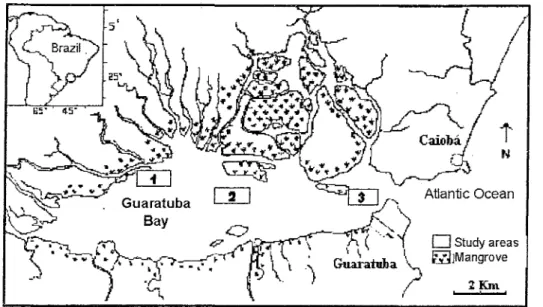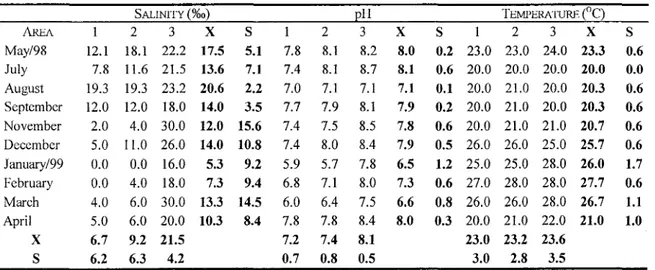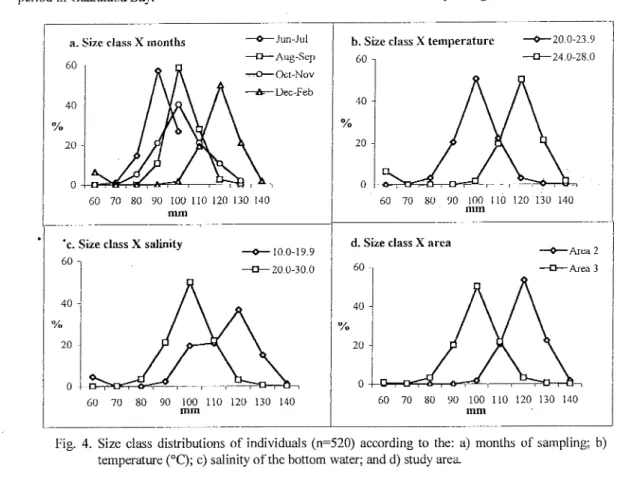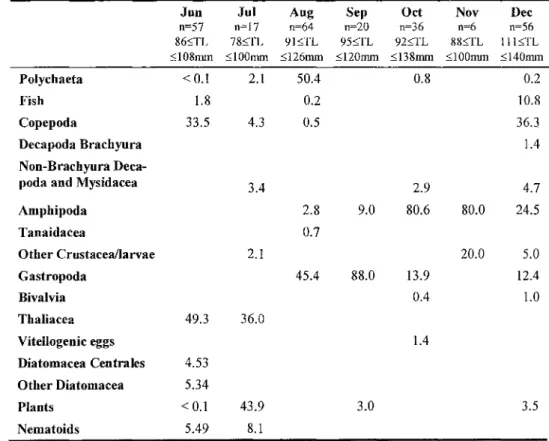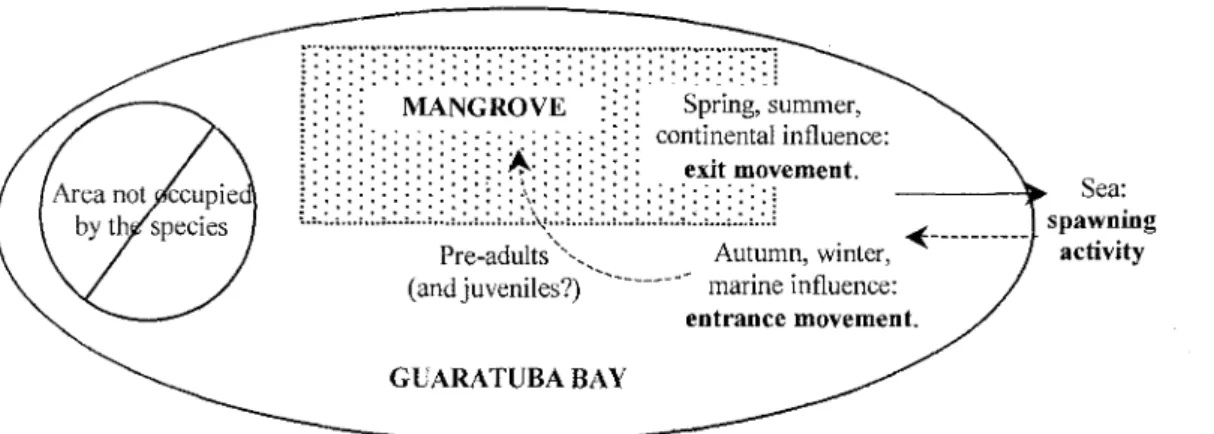Temporary use of a coastal ecosystem by the fish,
Pomadasys
corvinaeformis
(Perciformes: Haemulidae), at Guaratuba Bay, Brazil1
Paulo T. C. Chaves2 & Carlos E. Corrêa2
Universidade Federal do Paraná, Departamento de Zoologia (Caixa Postal 19020, 81531-990, Curitiba, PR, Brasil).
poissons@cce.ufpr.br
·
Abstract: Pomadasys corvinaeformisis one ofthe most abundant species found in Guaratuba Bay,an Atlantic coastal, estuarine ecosystem in Paraná, Brazil. We tested whether this species comprises a resident or migratorial population. Abundance, size distribution, and gonad development of individuaIs captured during the year show that pre-adults enter the system when salinities are greater (autumn and early winter). During this time, they are mostly associated with mangroves and adjacent areas. When salinities begin to fall (late spring and summer) these now maturing individuaIs return to the sea where they spawn. Thus,P. corvinaeformisis migratorial
and estuarine-dependent and uses this area prior to sexual maturity. During the period in this bay,
P. corvinaeformis presents a great plasticity of feeding habits, that include mainly Crustacea,
Mollusca and Thaliacea.
.
Resumo: Pomadm,ys corvinaeformisé uma das espécies de maior representatividade na ictiofaunada Baia de Guaratuba, litoral do Estado do Paraná. Este trabalho investigou se a espécie compõe ali uma população permanente, residente no sistema, ou se é migratória, fi"eqüentando-oapenas em épocas determinadas. Resultados de 12 meses sobre variações de abundância, distribuição de tamanho e aspectos reprodutivos indicam que indivíduos subadultos ingressam no sistema quando a salinidade é maior (outono, começo de inverno). Nesta época, os indivíduos utilizam a área de manguezal e suas adjacências. Quanto a sa1inidadecomeça a cair (final de primavera, verão), estes indivíduos agora em maturação gonadal retomam para o mar, onde desovam.P. corvinaefarmísé,
portanto, uma espécie migratória e estuarino-dependente que utiliza a Baía em período anterior ao de maturidade gonadal. Ali, apresenta uma dieta muito variada, constituída basicamente de Crustacea, Mollusca e Thaliacea.
.
Descriptors:Migration, Fish, Estuaries, Feeding habits, Haemulidae, Pomadasyidae..
Descritores:Migração, Peixes, Estuários, Alimentação, Haemulidae, Pomadasyidae.Introduction
Most species that inhabit estuarine systems are occasiona1 visitors or migrants through these systems. This tendency for fish to migrate through, rather than reside in, estuarine systems has been attributed to the wide fluctuation in environrnental conditions (Amanieu & Lasserre, 1982). In spite of variable environrnental conditions, some migrant
(1) Contr. number 1159 of the Department of Zoology/UFPR, Financial grants: CNPq and FUNPAR/UFPR.
(2) FeIlowships ofCNPq.
populations can reach greater abundance and biomass than that of other resident populations. In the mangroves of Guaratuba Bay, southem Brazil (28°52'S;48°39'W), some of the most common fish species (Bairdiella ronchus, Isopi:sthusparvipinnis,
threeEucinostomusspp.; Chaves, 1996; Chaveset a!.,
1998; Chaves & Orto, 1999) temporarily utilize the estuary as a "nurseryarea".
One ofthe most abundant ofthese species in the area is the roughneck grunt C'corcoroca"),
Pomadasys corvinaeformis (Steindachner, 1868)
2 Rev. bras. oceanogr., 48(1), 2000
usually occur in Guaratuba Bay within the range of sizes previously reported for this species: juveniles=40 mm (Costa et aI., 1995) and
maximum=250 mm (Menezes & Figueiredo, 1980). Corcoroca have no commercial importance in this region, but they take part in the food dynamic af the fish assemblage. They apparent1y leave the mangroves during spring and surnrner (cf. Chaves, 1998), but it is unknown whether they a) remain inside the Bay and spawn, or; b) leave the Bay, moving to the ocean, to spawn. Studies of other populations of this species report its occurrence in estuaries (Araújo et aI., 1998) and along coastal
oceanic beaches (Costaet aI.,1995). Here, spatial and
temporal occurrences of P. corvinaeformis are
examined in the Guaratuba Bay, near the mangroves studied by Chaves (op. cit.). We also examined the
dietary habits and compared with work outside of estuaries (Fortaleza beach, Brazil - Costa et aI., op. cit.).
Material and methods
Fish were collected monthly ITomMay 1998 to April 1999 in three areas ilIong an east-west transect of approximately 12 km, ITomthe Guanxuma river (area 1) to the proximity of the sea (area 3) (Fig. 1). We towed an otter trawl with a 20mm mesh monthly for seven minutes in waters 34m (depth) in each area. Bottom water salinity, pH and temperature (except in June and October) were also measured using a Van Dom bottle.
Fish specimens were weighed, measured (totallength, TL) and dissected to assess reproductive stage and sample stomach contents. Sex and maturation stage were evaluated by visual examination of gonads, using a four stage classification (immature, maturing, mature and spent; Vazzoler, 1996). Next, stomachs with food items were immediately fixed in a 10% formalin solution for later examination with a stereoscopic microscope. Contents were analyzed in two ways: !) ITequencyof occurrence (FO), defined as the proportion of stomachs that contained a given food item, and 2) proportional abundance (P), measured as the number of points covered by each item on a grid of points spaced 4 mm, divided by the total number of points occupied by the contents. Items were ranked using these two methods based on the Preponderance lndex (PI; Juras & Yamaguti, 1985):
where "( is each one ofthe "n" identified items. Ali variables used in statistical analysis were tested for normality, and when appropriate, parametric or non-parametric analyses were used. The abiotic characteristics in the three study areas were compared using ANOVA. These were compared monthly and for the entire study period. A five-year recorJ (1993-1998) of monthly rainfall collected nearby (Morretes IAPAR station, 30 km ITom Guaratuba Bay) explains salinity variation in the estuary (Fig. 2). Voucher specimens are deposited in Museu de História Natural Capão da Imbuia collection, Curitiba, Brazil (MNHCI 8260 to 8262).
16
14
May Joo Ju! Aug Sep Gel Nov Dee Jan Feb Mar Apr
Fig. 2. Rainfall (mean, standard deviation), fIom measurements taken at Morretes IAPAR (Instituto Ambienta! do Paraná) Station, January 1993 to October 1998.
Results
Salinity, pH, Temperature
-
Average salinity was significantly greater in area 3 than in areas 1 and 2 (F=16.9; d.f=2; p<O.Ol), which had similar salinity levels. January had the lowest salinity levels in ali three areas (Tab. I), and differences between areas were not significant (F=1.5; d.f=9; p>0.05). Rainfall was greatest during summer months resulting in the lower salinities (Fig. 2). Area 3 had the greatest average pH (X2=1O.14; d.f=2; p<O.Ol), but no monthly trends in pH were observed (X2=15.71; d.f=9; p>0.05) (Tab. 1). Water temperatures were not statistically different among the areas (X2=0.84; d.f=2; p>0.05), but did vary among months (X2=25.9; d.f=9; p<O.OI), with highest temperaturesduring summer (January-March) and lowest during winter (July-September) (Tab. 1).
Fish - A total of 520 individuais were netted, most between June and December (Fig. 3). Mean TL of these fish ranged fToma minimum of 66 mm
in February to a maximum of 140 mm in
December (Fig. 4a). The largest individuais were found at the highest temperatures and the lowest salinities (Figs 4b,c). No "corcoroca" were netted in January, March, April or May. During the other months, they were only netted in area 3, nearest ofthe sea, except December, when they were also taken in area 2 (n=64; 111:::;TL:::;140mm, the largest ofthe two areas - Fig. 4d).
Reproductive data - Sex ratio was 48% male : 52% female for 406 specimens. Fish in the "maturing" phase (n=27; 115:::;TL:::;140mm) were on1y found in area 2, in December (Tab. 2). AlI other specimens (n=379; 83:::;TL:::;135mm) were immature, and were found in areas 2 and 3. "Mature" or "spent" phase individuais were never captured.
Stomach contents - All specimens collected in February had empty stomachs. Thus, stomach contents are only compared for specimens (n=256) collected between June and December. The monthly abundance in the diet for the most common items, based on Preponderance Index values, varied widely (Fig. 5). Thaliacea, Gastropoda, Amphipoda, Copepoda and plants were the most common food items (Tab. 3). Polychaeta, Crustacea larvae and Diatomacea were a1socommon, presenting fTequency of occurrence greater than 10% and proportional abundance greater than 4%.
Table 1. Bottom salinity, pH and temperature values by month and sampling area (1 to 3) in Guaratuba Bay, during survey period. X: mean; S: standard error.
SALINITY (%0) pH TEMPERATURE(°C)
AREA 1 2 3 X S 1 2 3 X S 1 2 3 X S
May/98 12.1 18.1 22.2 17.5 5.1 7.8 8.1 8.2 8.0 0.2 23.0 23.0 24.0 23.3 0.6 July 7.8 11.6 21.5 13.6 7.1 7.4 8.1 8.7 8.1 0.6 20.0 20.0 20.0 20.0 0.0 August 19.3 19.3 23.2 20.6 2.2 7.0 7.1 7.1 7.1 0.1 20.0 21.0 20.0 20.3 0.6 September 12.0 12.0 18.0 14.0 3.5 7.7 7.9 8.1 7.9 0.2 20.0 21.0 20.0 20.3 0.6 November 2.0 4.0 30.0 12.0 15.6 7.4 7.5 8.5 7.8 0.6 20.0 21.0 21.0 20.7 0.6 December 5.0 11.0 26.0 14.0 10.8 7.4 8.0 8.4 7.9 0.5 26.0 26.0 25.0 25.7 0.6 January/99 0.0 0.0 16.0 5.3 9.2 5.9 5.7 7.8 6.5 1.2 25.0 25.0 28.0 26.0 1.7 February 0.0 4.0 18.0 7.3 9.4 6.8 7.1 8.0 7.3 0.6 27.0 28.0 28.0 27.7 0.6 March 4.0 6.0 30.0 13.3 14.5 6.0 6.4 7.5 6.6 0.8 26.0 26.0 28.0 26.7 1.1 April 5.0 6.0 20.0 10.3 8.4 7.8 7.8 8.4 8.0 0.3 20.0 21.0 22.0 21.0 1.0
X 6.7 9.2 21.5 7.2 7.4 8.1 23.0 23.2 23.6
4
1000
log n
100
10
60
May lun lu! Aug Sep Oet Nov Dee lan Feb Mar Apr
Fig. 3. Number (n), average length (X) and standard errar (S) of individuaIs caught montWy during the study period in Guaratuba Bay.
a. Size class X months -()- Jun-Jul
-[}- Aug-Sep -=O--Oct-Nov ~Dec-Feb 60
40
%
20
o
60 70 80 90 100 110110130 140 mm
.
c. Size class X saJinity60 -()-1O.0-19.9
-[}-20.0-30.0
40
O/o
20
o
60 70 80 90 100 110 120 130 140 mm
Rev. bras. oceanogr., 48(1),2000
Discussion
Because we never found mature or spent fish and corcoroca were primarily netted ITom June to December, we conclude that P. corvinaeformis
comprises a migratory population at Guaratuba Bay. During their time of inhabiting the bay, they are most common in two regions: the mangrove (Chaves, 1998) and the estuarine zone near the entrance to the sea (present results). In the mangroves, generally, larger individuaIs are found than in the second one. Abiotical parameters vary between the study areas and so perhaps the population distribution can be explained by the continental and marine influences that occur in each area. Salinity is minimal when rainfall is maximal (January) in the tributaries feeding into the bay (late spring and summer). This corresponds to the time when P. corvinaeformis
leaves the Bay and goes to the sea. Conversely, when
b. Size class X temperature 60
-()-20.0-23.9 -[}-24.0-28.0
40
% 20
o
60 70 80 90 100 110 120 130 140 mm
d. Size class X area
-()- Arca 2 -[}- Arca 3
60
40
O/o
20
o
60 70 80 90 100 110 120 130 140 mm
Fig. 4. Size class distributions of individuaIs (n=520) according to the: a) months of sampling; b) temperature (0C); c) salinity ofthe bottom water; and d) study area.
Table 2. Percentage of immature and maturingP. corvinaeformisindividuaIs in each month. December: area 2; other months: area 3; n: number of observations.
[ZIn _140
OX (+S,-S)
t
I
X(mm) L120 I{
m
[%j L100.
I m
80
n Immature Maturing
(%) (%)
June 8 100 O
July 5 100 O
August 267 100 O
September 26 100 O
Oetober 37 100 O
November 10 100 O
100
PI --o-- T haliacea
.. .[] - -. Gastropoda
-ir--- Amphipoda
- - -. - -. Copepoda --+--- Plants
80
60
40
20
D.
Jun Jul Aug Sep Oet Nov Dee
Fig. 5. Preponderance Index values distribution ofthe main food items ofP. corvinaeformis in Guaratuba Bay,
between June and December 1998. Size and number ofspecimens are in Table 3.
the rainfall is minimal (autumn/early winter), salinity is higher due to the increased marine influence in the bay. During this time, the pre-adults (and probably also juveniles) enter the estuary. This suggests that Guaratuba Bay is used during growth of individuaIs and acts as nursery area, as has been
shown for other estuarine systems (Yáfíez-Arancibia
et aI., 1993). Earliest phases were not collected,
probably because small, planktonic individuais are not netted at these depths and with the mesh size used. However, even during this time of suitable conditions for the fish, individuaIs never reach the inner areas ofthe Bay, but rather stay in and near area 3 (and very rarely to area 2), where marine conditions (greater salinity) is greatest. P. corvinaeformis does not appear to tolerate lower
salinities. Another Pomadasys species, P. commersonnii,also does not tolerate lower salinities,
due to variation in the water conductivity associated with pH levels rather than avoidance of elevated flows (Ter-Morshuizen et aI., 1996). P.
corvinaeformis is most abundant along coastal
areas of north-west Brazil (Fortaleza) during the rainy season, when salinities are low (Costaet aI.,
1995). Conversely, inside Guaratuba Bay during similar conditions ofhigh rainfàll, the population size is minimal or non-existent. Thus, P. corvinaeformis
enters the bay during periods of higher salinities and leaves the bay when salinities decline. Appearance in Guaratuba Bay (Fig. 6), therefore, seems to be influenced primarily by salinity.
Table 3. Preponderance Index ofthe stomach contents (except sand and non-identified material) ofP. corvinaeformisby month, between June and December 1998. n: number of observations; TL:
totallength. Mysidacea and Non-Brachyura Decapoda were combined.
Jun Jul Aug Sep Oct Nov Dec
n=57 n=17 n=64 n=20 n=36 n=6 n=56
86TL 78TL 91TL 95TL 92TL 88TL llbTL
108mm 100mm 126mm 120mm 138mm 100mm 140mm
Polychaeta < 0.1 2.1 50.4 0.8 0.2
Fish 1.8 0.2 10.8
Copepoda 33.5 4.3 0.5 36.3
Decapoda Brachyura 1.4
Non-Brachyura
Deca-poda and Mysidacea 3.4 2.9 4.7
Amphipoda 2.8 9.0 80.6 80.0 24.5
Tanaidacea 0.7
Other Crustacea/Iarvae 2.1 20.0 5.0
Gastropoda 45.4 88.0 13.9 12.4
Bivalvia 0.4 1.0
Thaliacea 49.3 36.0
Vitellogenic eggs 1.4
Diatomacea Centrales 4.53 Other Diatomacea 5.34
Plants < 0.1 43.9 3.0 3.5
6 Rev. bras. oceanogr., 48(1), 2000
Frrrr~'~'~':'J2:~'D2"~'~T')T'~':'~~L~::Lmmer,
!~ ~ ~ : : :
:
~:
::
::
::
:::
:::
::
::
:~~~ conti~ental influence:, . . . .+. . . eXIt movement.
.. . . o.. I . . . .
: .:.: . :.:.: .: . :.:.: .\: . : . : . :.: .: .:.:.: .:. ::
L;.:.;.:.;. :.;.:.;.:.;.:.; .:.;.:.;.:.;.\;:.;.:.; .:.;.:.;.:.;.:.;.:.;.:.;.:.;.:.~ . ~_ _ _ _ _ _ ____
Pre-adults "" Autumn, winter, (andjuveniles?) ',, marine influence:
entrance movement.
GUARATUBA BAY
Sea: spawning
activity
Fig. 6. Model depicting movements ofP. corvinaeformis in Guaratuba Bay, as suggested by the results presented herein.
Gonad maturation of P. corvinaeformis
occurs just prior to entry and during exit ITom the bay. Thus, these fish probably spawn at sea during summer, when salinities are lower in the bay. Another
Pomadasys species, P. jubelini ITom the eastem
Atlantic, may spawn in estuaries, but also has permanent populations in estuaries as well as in the ocean (Albaret, 1994). Size at first maturation is unknown. ln P. jubelini ITom the eastem Atlantic,
size at first maturation is estirnated at 130 mm (males) and 160 mm (females), while all individuaIs are mature at 150 and 170 mm, respectively (Albaret, 1994). These results suggest that individuaIs found in Guaratuba Bay are probably juveniles and maturing adults. Mature adults are unlikely to retum to the bay after spawning.
At Guaratuba Bay, P. corvinaeformis is
omnivorous, preferring invertebrates over plants, algae and fish in its diet. At Fortaleza beach, this species eats, in order of abundance, Crustacea, Polychaeta, fish and algae (Costa et aI., 1995).
Temporal and spatial variations iii ITequencyof each food type are probably associated to food requirements by each size class, implying a plasticity ofhabits that is associated with migration movements between different regions.
Acknowledgements
We would like to thank two anonymous reviewers for their suggestions on how to improve the manuscript.
References
Albaret, J. -J. 1994. Les poissons, biologie et peuplements. ln: Durand, J. R., Dufour, P., Guiral, D. & Zabi, S. G. F. eds. Environnement et ressources aquatiques de Côted'lvoire, Tome II -Les milieux lagunaires. Paris, Éditions de l'Orstom. p.239-279.
Amanieu, M. & Lasserre, G. 1982. Organisation et évolution des peuplements lagunaires. Oceanologica Acta, n. sp: 201-213.
Araújo, F. 0.; Cruz-Filho, A. G.; Azevedo, M. C. C. & Santos, A. C. A. 1998. Estrutura da comunidade de peixes demersais da Baía de Sepetiba, RJ. Rev. Brasil. Biol., 58(3):417-430.
Chaves, P. T. C. 1996. Atividade reprodutiva de
Bairdiella ronchus (Cuvier) (Pisces, Sciaenidae)
na Baía de Guaratuba, Paraná, Brasil. Revta bras. Zoo1., 12(4):759-766.
Chaves, P. T. C. 1998. Estrutura populacional de
Pomadasys corvinaeformis (Steindachner)
(Teleostei, Haemulidae) na Baía de Guaratuba, Paraná, Brasil. Revta bras. Zool., 15(1):203-209.
Chaves, P. T. C. & Bouchereau, J. -L. 1999. Biodiversité et dynamique des peuplements ichtyiques de Ia mangrove de Guaratuba, Brési1. Oceanologica Acta, 22(3):353-364.
Chaves, P. T. C. & Otto, G. 1999. The mangrove as a temporary habitat for fish: the Eucinostomus
species at Guaratuba Bay, Brazil
(25°52'S;48°39'W). Braz. Arch. Biol. Technol., Curitiba,42(1 ):61-68.
Chaves, P. T. c.; Rickli, A. & Bouchereau, J. -L. 1998. Stratégie d' occupation de Ia mangrove Ia baie de Guaratuba (Brésil) par le Sciaenidae prédateur Isopisthus parvipinnis (Teleostei,
Pisces). Cab. Biol. mar., 39(1):63-71.
Costa, P. S. R.; Santos, M. A. M.; Espínola, M. F. A. & Monteiro-Neto, C. 1995. Biologia e biometria
do corá, Pomada~ys corvinaeformis
Juras, A. A. & Yamaguti, N. 1985. Food and feeding habits of king weakfish, Macrodon ancylodon
(Bloch & Schneider, 1801) caught in the southem coast of Brazil. Bolm Inst. oceanogr., S Paulo, 33(2): 149-157.
Menezes, N. A. & Figueiredo, J. L. 1980. Manual de peixes marinhos do sudeste do Brasil. IV. Teleostei (3). Universidade de São Paulo, Museu de Zoologia. 96p.
Ter-Morshuizen, L. D.; Whitfield, A. K. & Paterson, A. W. 1996. Influence of fi'eshwater flow regime on fish assemblages in the Great Fish River and estuary. South. Afi'. J. Aquat. Sei., 22(1-2): 52-61.
Vazzoler, A. E. A. M. 1996. Biologia da reprodução de peixes teleósteos: teoria e prática. Maringá, EDUEM.169p.
Yáfiez-Arancibia, A.; Lara-Dominguez, A. L. & Day Jr, J. W. 1993. Interactions between mangrove and seagrass habitats mediated by estuarine nekton assemblages: coupling of primary and secondary production. Hydrobiologia, 264(1):1-12.
